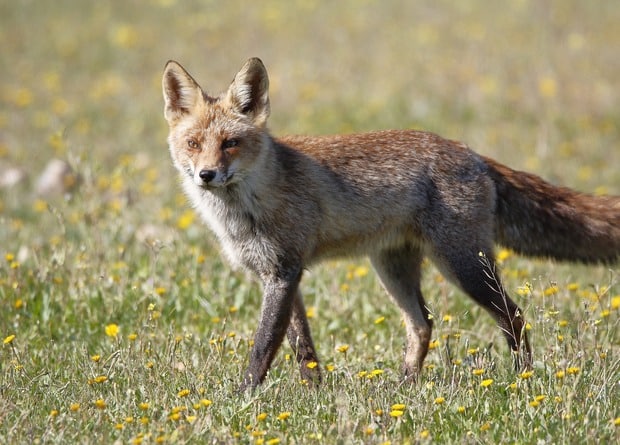Zoologists have discovered that foxes living in the Scottish Highlands regularly eat the excrement of domestic dogs. They feed most actively on them during periods with a low number of voles, their main prey. At the same time, only 300-600 grams of dog droppings is enough to provide the fox with energy for the whole day. As noted in an article for the journal Ecology and Evolution, foxes have not previously been observed to feed on dog feces.
Some animals do not disdain to eat the excrement of other species. For example, for the larvae of dung beetles (Scarabaeinae), the main source of food is the dung of mammals. Many sea birds occasionally eat the feces of whales, pinnipeds and polar bears, and stray dogs in India and Africa willingly feed on human excrement. In addition, scientists recently found that black-lipped pikas (Ochotona curzoniae) from the Tibetan highlands include more yak droppings in their diet in winter. This easily available and energy-rich food helps them get through the harshest months of the year without hibernating or stockpiling.
A similar example was described by a team of zoologists led by Xavier Lambin from the University of Aberdeen. In 2018-2019, researchers studied the diet of predatory mammals in the Cairngorms National Park in the Scottish Highlands. To do this, they collected animal feces and analyzed the vertebrate DNA they contained using metabarcoding. In total, the sample included more than 2,000 litter samples from common foxes (Vulpes vulpes), badgers (Meles meles), pine martens (Martes martes), as well as stoats (Mustela erminea) and weasels (M. nivalis).
In a study of 647 fox specimens, the authors found that 55.2 percent of the specimens contained the genetic material of the field voles (Microtus agrestis), a widespread and abundant rodent that feeds many predators in the Scottish Highlands. However, 39.1 percent of the samples unexpectedly contained domestic dog DNA. For comparison, in a study of 1,060 samples of pine martens droppings, the researchers found traces of vole DNA in 56.51 percent of them, and dog DNA in 0.85 percent.
The occurrence of dog and vole DNA in fox droppings varied from season to season. So, in the winter of 2018, the average chances of detecting canine DNA in the collected samples were 0.24. In the spring of 2018, winter 2019 and spring 2019, this probability was much higher – 0.39; 0.49; and 0.48, respectively. (p<0.01). The average probability of detecting vole DNA in fox droppings in the winter of 2018 was 0.93. After that, it significantly decreased and in the spring of 2018 it was 0.68, in the winter of 2019 – 0.19, and in the spring of 2019 – 0.36. Moreover, the more often vole DNA was found in fox droppings, the lower were the chances of detecting dog DNA in it.
The presence of canine DNA in almost half of the fox droppings is most easily explained by the fact that foxes eat the excrement of dogs that are walked by numerous visitors to the national park. It should be noted that previously zoologists have never recorded such behavior. However, alternative hypotheses seem much less plausible. For example, foxes clearly do not prey on dogs. In theory, they could get canine DNA from carrion, but in that case, an unbelievably large number of dogs would die in the study area. Some of the dog DNA probably got into the fox droppings from dogs urinating on it or rolling around in it while walking. However, this does not explain why the likelihood of finding dog genetic material in fox feces varies from season to season and is negatively correlated with the chance of detecting vole DNA in them.
The number of field voles, like many other small rodents, varies greatly from year to year. The researchers hypothesized that during periods when voles are scarce, such as spring 2018, winter 2019, and spring 2019, foxes switch to feeding on dog feces. However, it remained unclear how energetically valuable such a source of food was. To test this, the authors analyzed the faeces of six domestic dogs in a calorimeter. It turned out that on average, dog litter contains 135 kilocalories per 100 grams of wet weight. This is comparable to the energy value of small rodents, which is 137-170 kilocalories per 100 grams. According to scientists, to provide the average fox with sufficient energy, 300-600 grams of dog feces per day is enough.
The results of the study suggest that many cases of interspecies coprophagia go unnoticed. It is possible that this phenomenon is much more widespread in nature than is commonly believed. However, it should be noted that, unlike foxes, other Scottish predators did not eat dog droppings. Thus, coprophagy is perhaps most likely between species with close trophic niches.
Plastic behavior and ecological flexibility allow foxes to develop very unusual food sources. For example, in London they willingly eat dead cats. And at the Washington Zoo, a wild fox broke into a waterfowl enclosure and killed twenty-five red flamingos (Phoenicopterus ruber) and one duck.
Photo: Common fox (Vulpes vulpes) / Wikimedia Commons









